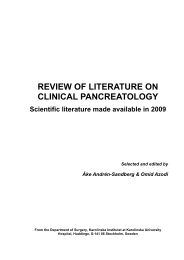Isolation, Purification and Protein Content of Pancreatic ...
Isolation, Purification and Protein Content of Pancreatic ...
Isolation, Purification and Protein Content of Pancreatic ...
You also want an ePaper? Increase the reach of your titles
YUMPU automatically turns print PDFs into web optimized ePapers that Google loves.
the Pancreapedia entry by Dingsdale et al (11).1. Materials for <strong>Isolation</strong> <strong>of</strong> ER1.1 Rat or mouse pancreas as desired fromcontrol or treated animals.1.2 Motor driven Potter – Elevjhem homogenizer.The glass Teflon homogenizer can be purchasedfrom Kontes, Wheaton or Charles Thomas. Weuse a Charles Thomas Size B or Kontes size 22for rat or mouse pancreas <strong>and</strong> a Kontes size 20for isolated acini. For homogenizing intactpancreas first mince the tissue with scissors toenhance tissue breakdown. We then used aserrated pestle to prepare the homogenate. Themost important aspect is the clearance whichgenerally increases with the size <strong>of</strong> the chambervolume. The Kontes homogenizers generallyhave a smaller clearance. A Polytron typehomogenizer should not be used because it willdisrupt cellular organelles <strong>and</strong> fragment all cellularmembranes.1.3 A high speed refrigerated centrifuge <strong>and</strong> anultracentrifuge. We use Beckman ultracentrifugeswith a Ti70 angle head <strong>and</strong> a SW-41 swingingbucket rotors with appropriate tubes.1.4 A 2M sucrose stock for preparingdiscontinuous sucrose gradients.1.5 A homogenizing solution <strong>of</strong> 0.3 M sucrose, 10mM Hepes-NaOH (pH 7.0 at 4 0 C) with 2mMdithiothreitol <strong>and</strong> protease inhibitors usually 1mMbenzamidine, 0.5 mM PMSF (freshly added froma 100 mM stock in ethanol) <strong>and</strong> 150-200 units/ml<strong>of</strong> aprotinin, a kallikrein inhibitor. For studies <strong>of</strong>protein phosphorylation, kinase <strong>and</strong> phosphataseinhibitors can be added.1.6 A solution <strong>of</strong> 1 M KCl <strong>and</strong> 1 mM puromycin forremoving ribosomes.2. Methods for <strong>Isolation</strong> <strong>of</strong> ER2.1 Rat or mouse pancreas is homogenized in 5-10 volumes <strong>of</strong> ice-cold homogenizing solution byuse <strong>of</strong> a motor driven glass Teflon homogenizer atmedium speed. For pancreas 7-10 strokes over 1min at about 1000 rpm is usually sufficient. Forisolated acini, the acinar suspension iscentrifuged at low speed (50-100 g) <strong>and</strong> washedin either calcium free KHB or PBS <strong>and</strong>resuspended in 10 volumes homogenizingsolution. Homogenization requires 15- 25 strokes<strong>of</strong> the motorized pestle.2.2 The homogenate is first centrifuged at 500-1000 g for 10 min <strong>and</strong> the supernatant thencentrifuged at 12,000 g for 10-20 min to removeall debris, nuclei, zymogen granules <strong>and</strong>mitochondria. If you set the final spin at the highend <strong>of</strong> the g x time range ( 12,000 g for 15 min)you will remove mitochondria more completely,but will lose some RER.2.3 To collect vesiculated ER also referred to as“microsomes”, one <strong>of</strong> the following procedures isused.a. Centrifugation at 150,000 g for 30 min or100,000 g for 60 min in the Ti 70 rotor orequivalent to obtain total microsomes. (Note1)b. Centrifugation at 27,000 g for 10-20 min toobtain a heavy microsomal fraction whichcontains primarily RER (17). This method hasthe advantage <strong>of</strong> speed but is less pure thanmethod c.c. Centrifugation at 100,000 g for 60 min in a SW27 or SW 41 rotor <strong>of</strong> a gradient prepared bylayering 4 ml <strong>of</strong> the postmitochondrialsupernatant on top <strong>of</strong> a 2ml cushion <strong>of</strong> 1.3 Msucrose buffered with 10 mM Hepes (pH 7.0)<strong>and</strong> supplemented with 1 mM MgCl 2 , 2 mMDTT <strong>and</strong> protease inhibitors. Purified roughmicrosomes are collected at the bottom <strong>of</strong> thetube (22).2.4 <strong>Purification</strong> <strong>of</strong> both RER <strong>and</strong> SER is by theworkflow shown in Fig 1. The total microsomalpellet prepared as in 2.3a is resuspended in 1.25M sucrose, 20 mM Hepes with benzamidine, DTT<strong>and</strong> PMSF homogenizing solution (see point 1.5)2












